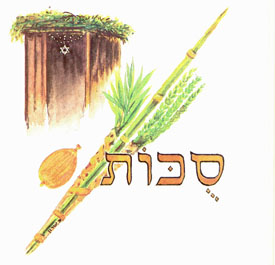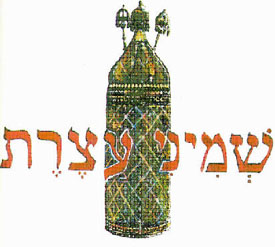

January 7, 2026 ~ Sh SHEMOT. RAST / BAYAT

Introduction by Sam Catton
On this holiday, which occurs four days after Yom Kippur, Israel is commanded to dwell in make-shift booths for seven days and to bring together the four species of the Lulab cluster, the citron, the palm branch, the myrtle and the willow of the brook. These were waved as the worshippers encircled the Altar in the Temple. Today, the Synagogue Tebah replaces the Temple Altar. The complete Hallel is recited.
Thus, the people leave their homes of comfort, and enter into the frail booths for seven days to remind us of our forty years of traveling in the desert, where we had no homes, and where the Lord protected us from all the dangers during the most difficult years.
Succot is a very [happy] holiday. The people came from all parts of the country to celebrate in Jerusalem. Their jubilation was two-fold. Secure in the knowledge that their prayers were accepted on Yom Kippur, and extremely grateful for granaries and storehouses filled with the ingathering of all the produce of the fields. Everyone is commanded to rejoice during these seven days with their families, and thank the Almighty for all the blessings He has showered upon us.
As we fulfill God's commandment of dwelling in the Succah, of holding the Lulab, by refraining from work, and by rejoicing in the Holiday, we indicate our fear and our love of God.
Succot (סֻכּוֹת), the festival of Tabernacles/Booths, is celebrated on 15 Tishrei.
Maqamat: 1 Sukkot- Sigah; 2 Sukkot- Ajam; Shabbat Hol Hamoed- Bayat; Hoshana Rabbah- Yom Kippur Melodies; Shemini Aseret- Saba; Simhat Torah- Ajam

Introduction by Sam Catton
After the joyful observance of Succot, the Lord pleads with Israel to remain in Jerusalem an extension of one more day to the Succot Holiday; a one day individual holiday by itself known as Shemini Hag Aseret. God is saddened at the thought of the people going back home.
On this day, prayers were offered to the Lord to provide us with enough rainfall for our crops and for all other needs.
At this point, the cycle of the weekly Sabbath Torah readings is completed, and immediately a new cycle begins.
This day is also known as Simhat Torah, rejoicing in the Law. Unrestrained dancing with the Torah is accompanied with singing takes place. The Tebah is encircled seven times in a ceremony known as "Hakafot". Children of all ages participate. Candies, goodies, toys, and flags are generously distributed to children, thus instilling in them a love of Torah and of this holiday. The children overflow the Synagogues. Every inch of space is occupied.
שמיני עצרת=Saba ("the eighth day") שמחת תורה=Ajam
| Section | Pizmon | Page | Song | Commentary | Recordings | Application |
|---|---|---|---|---|---|---|
| Sigah | 518 | 435 | אתה מרום | This pizmon (SIGAH, page 435), whose title is translated as "You, Who Lives in Heaven and Resides Above," is a song for the Yom Tob festivals. The acrostic of this song is Abraham (אברהם), and there is a reference here to each of the three patriarchs. What makes this song unique is that each of the five rhyming stanzas ends with a biblical source referencing God's name. The song begins with how the author and the entire community will rejoice and praise God at happy occasions; in the happiness of the bride and groom (in the first stanza), and in the happiness of the Yom Tob festivals (in the second stanza). The third stanza then asks that God, the merciful One, will spread his kindness on the children of Abraham. The fourth stanza says that we should praise God, because He will rebuild the Beit HaMiqdash where we will soon offer sacrifices to God in the future. The poem concludes (in the fifth stanza) with a plea to fulfill the prophecy of Ezekiel of returning to Zion, rebuilding the Temple, and then sending the Messiah, from the House of King David, to redeem the Jewish nation. Due to the song’s clear reference to “Eleh Moadei Hashem (Leviticus 23:4),” the source in the Torah that discusses the annual holiday cycle, this can be used as a PIZMON SEFER TORAH on the Shalosh Regalim. Tabbush Manuscript |
E. Menaged G. Shrem M. Kairey G. Shrem Recording Moshe Dwek |
|
| Mahour | 181 | 151 | חנון רחם |
M Kairey Albert Cohen Saban G. Shrem Recording I Cabasso |
פזמון | |
| Bayat | 319 | 246 | מעזי אז כלה קץ |
N. Salem Ezra Sayegh E. Menaged Fule Yanani I. Cabasso- Shav'at G. Shrem Recording R Barzani- Shaveat I Cabasso E Sayegh D Binker-Duek Moshe Dwek Moshe Dwek Moshe Dwek - SA Moshe Dwek - Mauzi I CABASSO SHAVAT ANIYIM |
שועת עניים | |
| Nahwand | 299.03 | 237c | שאו ציונה נס ודגל | Early Israeli melody. |
Recording |
|
| Hijaz | 585 | 485 | רוכב עבים ומהלך |
E. Menaged G. Shrem Recording I Cabasso H Abraham Zafrani I CABASSO SHAVAT ANIYIM |
שועת עניים | |
| Ajam | 215 | 173 | מקהלות עם |
M Kairey G. Shrem Fule Yanani Saul Nobeh Betesh G. Shrem Recording I Cabasso Eliahu Saal- Qaddish Moshe Dwek Moshe Dwek - Naqdishakh |
נקדישך | |
| Ajam | 221.01 | 176a | סוכה ולולב | Sukkot. There are many melodies to this pizmon; including Maqam Ajam and Saba. |
J. Mosseri Recording Recording Iraqi Recording Dr Isaac S Mordecai |
|
| Hijaz | 595 | 493 | בואו נספר | Hoshana Raba. Yabess Manuscript A Z Idelsohn notes, 1923 |
G. Shrem G. Shrem Recording Moshe Dwek - HM |
|
| Rahawi Nawah | 448 | 370 | מפי אל מפי אל |
G. Shrem Fule Yanani G. Shrem Moshe Dwek Dr Isaac S Mordecai |
אל ההודאות | |
| Ajam | 228 | 179 | אל רמה ימינך |
Yom Tob Yanani David Sebi Recording |
שועת עניים | |
| Bayat | 326 | 249 | ארוממך לכבוד שמך | This pizmon (BAYAT, page 249), “I Will Exalt Thee,” is associated with the Shalosh Regalim festivals, and specifically Sukkot. This rhyming song is composed by H Raphael Antebi Tabbush (d. 1918). The theme of the song is praising God during the joyous pilgrimage to the Temple in Jerusalem. Among the reasons listed of why God is praised are: He performed miracles for us, destroyed our enemies, gave us the Torah, lifted us from bondage, forgives our transgressions, listens to our cries, and heals the sick. In this song, there are 22 stanzas, corresponding to the letters of the Hebrew alphabet, and each stanza ends with the chorus: “Le’ir Sion, Har Qodshekha, Sham Nismah Ve’naale” (To the City of Zion, Your Holy Mountain; There will we rejoice and ascend). The last stanza is a prayer for the arrival of Eliahou to herald the redemption, which "everyone is yearning for.” In addition to singing “Aromimkha” on the Shalosh Regalim, it is commonly chanted during the Haqafot of Simhat Torah. The melody of this can be applied to Mimisrayim on Shabbat Hol Hamoed. Tabbush Manuscript |
Fule Yanani G. Shrem Moshe Dwek |
ממצרים |